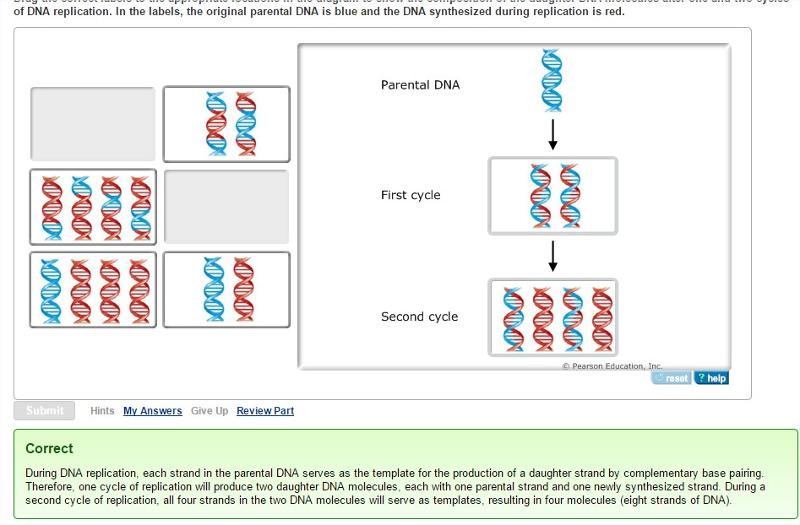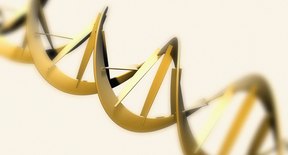41 dna structure and labels
The Structure and Function of DNA - Molecular Biology of the Cell ... A DNA Molecule Consists of Two Complementary Chains of Nucleotides A DNAmoleculeconsists of two long polynucleotide chains composed of four types of nucleotidesubunits. Each of these chains is known as a DNA chain, or a DNA strand. Hydrogen bondsbetween the baseportions of the nucleotides hold the two chains together (Figure 4-3). DNA - structure The final piece that we need to add to this structure before we can build a DNA strand is one of four complicated organic bases. In DNA, these bases are cytosine (C), thymine (T), adenine (A) and guanine (G). Note: These are called "bases" because that is exactly what they are in chemical terms.
DNA Structure | Biology Dictionary The base pairs of DNA are: Adenine-thymine Guanine-cytosine Base pairs in DNA The two strands of the double helix run in opposite directions to one another, meaning that the 5' end of one strand faces the 3' end of the other. This is called the antiparallel orientation, and it is essential for successful DNA replication.

Dna structure and labels
What Is DNA?- Meaning, DNA Types, Structure and Functions The DNA structure can be thought of as a twisted ladder. This structure is described as a double-helix, as illustrated in the figure above. It is a nucleic acid, and all nucleic acids are made up of nucleotides.The DNA molecule is composed of units called DNA Transcription | Learn Science at Scitable - Nature The process of making a ribonucleic acid (RNA) copy of a DNA (deoxyribonucleic acid) molecule, called transcription, is necessary for all forms of life. The mechanisms involved in transcription ... DNA structure and replication review (article) | Khan Academy DNA structure and replication review. AP.BIO: IST‑1 (EU), IST‑1.M (LO), IST‑1.M.1 (EK) Google Classroom Facebook Twitter. Email. Replication. Antiparallel structure of DNA strands. Leading and lagging strands in DNA replication. Speed and precision of DNA replication. Semi conservative replication.
Dna structure and labels. Structure of DNA - Higher Biology Revision - BBC Bitesize DNA is the molecule that holds the instructions for growth and development in every living thing. Its structure is described as a double-stranded helix held together by complementary base pairs.... DNA Molecule Label Diagram | Quizlet Molecule found on the side of a DNA molecule Double Helix two strands of nucleotides wound about each other; structure of DNA Thymine the nucleotide that hydrogen bonds with the nucleotide adenine in DNA Adenine the nucleotide that hydrogen bonds with the nucleotide thymine in DNA or with uracil in RNA Guamine The Irish DNA Atlas: Revealing Fine-Scale Population ... Dec 08, 2017 · The extent of population structure within Ireland is largely unknown, as is the impact of historical migrations. ... Utilising the ‘Irish DNA Atlas’, a cohort (n = 194) of Irish individuals ... DNA Structure with Labels - Rae Rocks Teaching DNA Structure with Labels Help your students finally understand DNA structure with labels to help them along the way. Nearly 65% of people are visual learners which make graphics key to engaging students. This no-prep lesson provides all the basics you need to provide students to grasp the structure of DNA. $ 4.99 Add to cart
The Structure Of DNA and RNA : Plantlet A DNA molecule consists of two polynucleotide chains, linked by hydrogen bonds between bases. In DNA there are four bases - adenine always pairs with thymine, and cytosine always pairs with guanine. RNA, which comes in several diff erent forms, has only one polynucleotide chain, although this may be twisted back on itself, as in tRNA. DNA Structure Labeling Diagram | Quizlet the spiral-staircase structure characteristic of the DNA molecule nitrogen base a subunit of a nucleotide in DNA and RNA pyrimidine a nitrogen base that has a single-ring structure (thymine, cytosine, and uracil) purine a nitrogen base that has a double-ring structure (adenine and guanine) thymine pairs with adenine adenine pairs with thymine Structure of DNA: Primary and secondary structure The primary structure of DNA is simply the sequence of nucleotides. The sugar-phosphate chain is called the DNA backbone, and it is constant throughout the entire DNA molecule. The variable portion of DNA is the sequence of nitrogenous bases. The phosphate groups link the 3rd carbon of one sugar (of deoxyribose or ribose) to the 5th carbon of ... The Structure of DNA The Structure of DNA The Structure of DNA This figure is a diagram of a short stretch of a DNA molecule which is unwound and flattened for clarity. The boxed area at the lower left encloses one nucleotide. Each nucleotide is itself make of three subunits: A five carbon sugar called deoxyribose (Labeled S)
3.3.5 Draw a simple diagram of DNA structure - YouTube 3.3.5 Draw and label a simple diagram of the molecular structure of DNA.Here I demonstrate drawing the structure of DNA. You don't need to be an artist, its... DNA: Structure, Forms and Functions (With Diagram) DNA contains β D 2′-deoxyribose sugar. It is a five-carbon sugar; hence it is a pentose sugar. Since one oxygen atom at the 2′ carbon is missing it get its name 2′-deoxy. The 2′- deoxy-containing backbone is more resistant to hydrolysis than the riboform. D-ribose does not mean dextrorotary ribose. PDF The Components & Structure of DNA - Central Bucks School District The Components & Structure of DNA The Components & Structure of DNA •Long chain made up of units called nucleotides •Nucleotides are made up of three basic components •5-carbon sugar = deoxyribose •Phosphate group •Nitrogenous bases •Purines - Adenine and Guanine •Pyrimidines - Thymine and Cytosine The Components & Structure of DNA How you can Label a DNA Structure - Biology | ScienceBriefss.com DNA is made of chemical building blocks called nucleotides. These building blocks are made of three parts: a phosphate group, a sugar group and one of four types of nitrogen bases. Why Labelling is important in DNA? Nucleic acids are readily labeled with tags that facilitate detection or purification.
DNA Structure and Shape | Ask A Biologist Image by Madprime via Wikimedia Commons. A closer look at the chemical structure of DNA shows four main building blocks. We call these nitrogenous bases: Adenine (A), Thymine (T), Guanine (G), and Cytosine (C). DNA also includes sugars and phosphate groups (made of phosphorus and oxygen). These make the phosphate-deoxyribose backbone.
DNA - Wikipedia DNA is a long polymer made from repeating units called nucleotides, each of which is usually symbolized by a single letter: either A, T, C, or G. The structure of DNA is dynamic along its length, being capable of coiling into tight loops and other shapes. In all species it is composed of two helical chains, bound to each other by hydrogen bonds. ...
DNA function & structure (with diagram) (article) | Khan Academy Chromosomal DNA consists of two DNA polymers that make up a 3-dimensional (3D) structure called a double helix. In a double helix structure, the strands of DNA run antiparallel, meaning the 5' end of one DNA strand is parallel with the 3' end of the other DNA strand.
9.1 The Structure of DNA - Concepts of Biology - 1st Canadian Edition A DNA molecule is composed of two strands. Each strand is composed of nucleotides bonded together covalently between the phosphate group of one and the deoxyribose sugar of the next. From this backbone extend the bases. The bases of one strand bond to the bases of the second strand with hydrogen bonds.
Capillary electrophoresis applied to DNA: determining and ... May 03, 2015 · The use of these materials as DNA separation matrices stems from an aqueous micelle structure that allows for higher concentration polymer solutions to be implemented for sieving while keeping a very low viscosity, e.g., a 15 % Pluronic F108 matrix has a viscosity of only 21 cP .
PDF DNA Structure Worksheet - Commack Schools 1. What do the letters DNA stand for? 2. DNA is a polymer, which means that is made up of many repeating single units (monomers). What are the monomers called? 3. The "backbone" of the DNA molecule is made up of two alternating components, what are these? 4.
DNA Structure and Sequencing | Boundless Biology | | Course Hero DNA Structure: DNA has (a) a double helix structure and (b) phosphodiester bonds. The (c) major and minor grooves are binding sites for DNA binding proteins during processes such as transcription (the copying of RNA from DNA) and replication. ... The ddNTPs which terminate the strands have fluorescent labels covalently attached to them. Each of ...
DNA Structure - University of Arizona For each question, you will be directed to a special view of DNA for use in answering the question. Good luck! Identifying the location of phosphate groups. Is DNA a right- or left-handed helix? Grooves in the DNA double helix. The deoxyribose sugar ring. Is the deoxyribose ring flat or puckered? Location of the sugar in the DNA double helix.
Review the Structure of DNA - The Biology Corner This worksheet shows a diagram of DNA and asks students to label it; also includes questions about the structure, function, and history of DNA. Name: _____ Review the Structure of DNA. 1. On the image above, label: Phosphate; Deoxyribose; Hydrogen Bonds; Each of the four bases: adenine, guanine, cytosine, thymine; 2. ...
Stages of transcription: initiation, elongation & termination ... An in-depth looks at how transcription works. Initiation (promoters), elongation, and termination.
DNA ligase - Wikipedia DNA ligase is a specific type of enzyme, a ligase, (EC 6.5.1.1) that facilitates the joining of DNA strands together by catalyzing the formation of a phosphodiester bond.It plays a role in repairing single-strand breaks in duplex DNA in living organisms, but some forms (such as DNA ligase IV) may specifically repair double-strand breaks (i.e. a break in both complementary strands of DNA).
DNA STRUCTURE -- OUTLINE - Tusculum University A single-ring structure. Includes thymine, uracil, and cytosine. Uracil is found only in RNA and thymine only in DNA. The nitrogen and carbon atoms are numbered 1 - 6. These are linked to sugars via a n-glycosidic bond. The 1' carbon of the pentose is bonded to the 6 nitrogen of the base. Base pairings.
Bio 102 Practice Problems Chromosomes and DNA Replication DNA polymerase requires a single-stranded template, a primer and nucleotides and can only add nucleotides to an existing 3’ end. In the left molecule, there are two 3’ ends that DNA polymerase could add to by reading the single-stranded segments. So DNA polymerase could add nucleotides until it reached the end of the template, as shown in
The Structure of DNA - Concepts of Biology The building blocks of DNA are nucleotides, which are made up of three parts: a deoxyribose (5-carbon sugar), a phosphate group, and a nitrogenous base ( [Figure 2] ). There are four types of nitrogenous bases in DNA. Adenine (A) and guanine (G) are double-ringed purines, and cytosine (C) and thymine (T) are smaller, single-ringed pyrimidines.

Pin by shanon hernandez on Homeschool - Science - Human Anatomy | Dna model project, Dna project ...
DNA Structure - Visible Body Each DNA strand is composed of nucleotides—units made up of a sugar (deoxyribose), a phosphate group, and a nitrogenous base. Each strand of DNA is a polynucleotide composed of units called nucleotides. A nucleotide has three components: a sugar molecule, a phosphate group, and a nitrogenous base.
Nucleotide Structure: DNA Diagram | Science Trends DNA is known for its double helix structure. The double helix is two strands that are intertwined with one another thanks to the complementary bases. RNA is a single-stranded molecule by contrast. The double helix form of DNA helps keep the genetic code intact.







Post a Comment for "41 dna structure and labels"